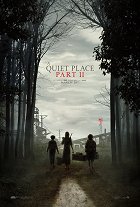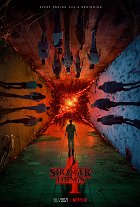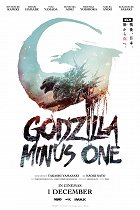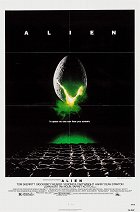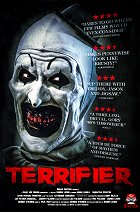Horror - Genres
Hottest on Streaming Today
Horror before the invention of cinema
Horror is a classic fictional genre that aims to evoke feelings of terror and fear, or even to frighten or shock people. Meeting the specifics of the genre does not depend so much on the content of the work as on its form – any story can be portrayed as horror if the narrator so desires. In addition, horror can be combined with other genres, such as fantasy, detective, comedy, thriller or science fiction. Because of their nature, which is to evoke negative emotions, horror films are often considered a lowly genre, but they can become full-fledged works of art if they meet the high aesthetic standards usually imposed on other genres.
Horror themes often disrupt everyday reality with the presence of something supernatural that is haunting and awakens the fear of the unknown. Typical characters in horror films are therefore ghosts, ghouls, mysterious dark forces, demons, infernal or alien beings, witches, vampires, werewolves, various monsters, and zombies. Among the more realistic elements, we can mention, for example, feral animals, psychopaths and serial killers, disasters of all kinds, and blood, torture or various forms of terror.
Ancient legends and myths already featured frightening elements and scary situations, for example in ancient Chinese and Japanese folklore there are stories about demons and vampires, which in many cases became the archetypal model for many later horror films. Modern horror evolved from English gothic novels written in the late 18th century, and was later followed by authors such as Bram Stoker ("Dracula"), Mary Shelley ("Frankenstein"), Robert Louis Stevenson ("The Strange Case of Dr. Jekyll and Mr. Hyde“) and Edgar Allan Poe (“The Pit and the Pendulum“, “The Black Cat“). Some of the darker fairy tales by the Brothers Grimm or Hans Christian Andersen can also be frightening. This is why horror films in their early days took inspiration from literature, and in some cases still do today.
First horror films
The very first horror film is considered to be The House of the Devil, made in 1896 by French director and visual effects pioneer Georges Méliès. The antagonist of the three-minute film was the ruler of hell himself, who appears at the beginning as a bat, then takes on human form and begins to haunt a couple of travellers with his magic until he is driven away by a crucifix at the end. Later Méliès's films also featured props such as skeletons, mysterious supernatural forces, and a man wrestling with a giant spider, all of which could be considered early horror motifs. At the beginning of the 20th century, Georges Méliès also made several different versions of Faust, the most famous of which were Faust in Hell (1903) and its sequel Faust and Marguerite (1904), both inspired by famous operas.
American director George Albert Smith made his own version of Méliès's first horror film in 1897 and also a number of other short films using skeletons and ghosts. Like the two aforementioned filmmakers, Spanish-French director Segundo de Chomón, renowned for his cinematic optical illusions and camera tricks, was also famous for his short films Satan at Play (1907), in which we follow a series of the Devil's favourite activities, and The Haunted House (1908), one of the first films to use the haunted house motif. All of these films also represented the advent of effect-movies, in which supernatural phenomena and magic were created through make-up, costumes, and, most importantly, film editing. They were especially popular at the turn of the century, and the techniques used to make them became the forerunners of special effects.
Frankenstein received its first film adaptation in 1910, followed by two versions of Dr. Jekyll and Mr. Hyde, one in 1912 and the other a year later (the very first adaptation from 1908 has not survived). In 1911, the more than one-hour long Italian silent film Dante's Inferno, an adaptation of the first part of Alighieri's "The Divine Comedy", became an international sensation with its faithful depiction of not only the character of Lucifer but also all nine circles of hell. Between 1915 and 1916, France produced a ten-part epic called The Vampires, about a gang of criminals posing as vampires who spread fear among the public and the policemen who are on their trail.
Frankenstein (1910)
Photo © Edison Manufacturing Company
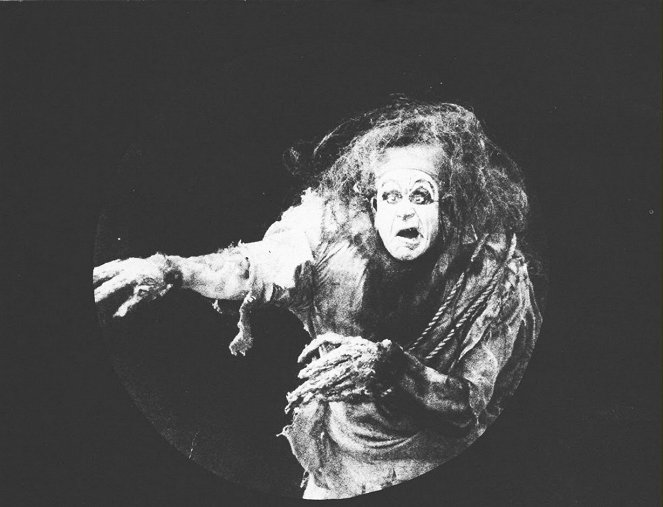
German Expressionism
After the end of World War I, Germany saw a boom in horror films that used a specific type of lighting (mostly from the front and sides), worked imaginatively with shadows and the camera, and featured impressive distorted sets, striking makeup effects, and overly dramatic acting. This wave, known as Expressionism, became an inspiration for many later filmmakers from all over the world, and most importantly, its unified and unique style showed how to effectively create a horror atmosphere and how to use it to tell a story.
The Cabinet of Dr. Caligari (1920), directed by Robert Wiene, is considered to be the work that marks the beginning of film Expressionism, and after its enormous success the number of expressionist films grew considerably. Thanks to its horror theme about a student haunted by his mirror image, the pre-war German film The Student of Prague (1913) is also mistakenly referred to by the same appellation, but its visual execution does not correspond to later ideas of Expressionism and for this reason it was remade in 1926.
The peak of this movement, however, was Nosferatu (1922), an unacknowledged adaptation of Dracula, for which the director Friedrich Wilhelm Murnau failed to obtain the rights, so he set the story in different locations and renamed the characters. This film about Hutter, a clerk who goes to the Carpathian mountains in search of Count Orlok, who turns out to be a vampire, is often ranked among the most artistically important films of all time. Other major German Expressionist horror stories include Warning Shadows (1923) and the anthology Waxworks (1924), which combined other genres besides horror.
The Cabinet of Dr. Caligari (1920)
Photo © Decla-Bioscop
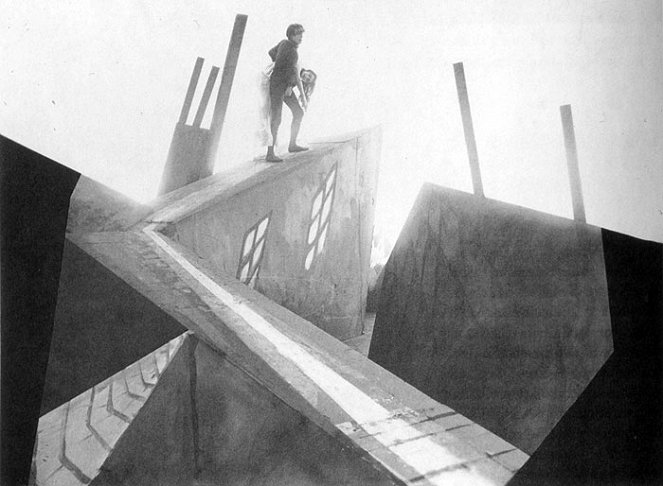
Classic monsters of the Universal Studios
Some early American films also used horror themes, but the term "horror" did not come into use as a description of the genre until the 1930s, when Universal made this type of film famous. This began in the 1920s with films inspired by Gothic novels, the first of which was The Hunchback of Notre Dame (1923) with the hunchback Quasimodo, followed by The Phantom of the Opera (1925) with the character of the disfigured Erik, and The Cat and the Canary (1927), which enriched the mystery theme with grotesque elements. These films were already clearly influenced by German Expressionism (some German filmmakers also emigrated to the USA at the time) and their success was also due to the emergence of sound.
However, it would be the horror films made in the 1930s by Universal that became well-known classics; commercially successful hits in their time (this is why this period is referred to as the golden age of monster movies), they are still considered canonical works of world horror. This legendary series began in 1931 with the films Dracula and Frankenstein, the former starring Bela Lugosi as the title vampire and the latter starring Boris Karloff as Frankenstein's monster, and both actors were subsequently cast in leading roles in other horror films by the same studio.
The Mummy, about the awakened mummified body of an Egyptian pharaoh, was released in 1932, followed a year later by The Invisible Man, about a scientist who discovers an invisibility serum and embarks on a career as a criminal, and Bride of Frankenstein in 1935, a sequel to Frankenstein, in which the lonely monster is given a mate. Only a month after the premiere of Bride of Frankenstein, Werewolf of London was released as the first ever major Hollywood film about a werewolf, and its theme was later reworked into The Wolf Man starring Lon Chaney Jr. in 1941. In 1936, Universal released a sequel to Dracula called Dracula's Daughter, telling the story of a vampire who longed to live a normal life, and seven years later, in 1943, the trilogy came to a close with Son of Dracula.
At the turn of the 1930s and 40s, Universal profited mainly from countless sequels to its horror hits, including Son of Frankenstein (1939), The Invisible Man Returns (1940), The Invisible Woman (1940), The Ghost of Frankenstein, as well as many sequels to The Mummy and several crossovers, such as Frankenstein Meets the Wolf Man (1943). In addition, the studio made a number of horror adaptations based on the works of Edgar Allan Poe, and other horror films that were also popular, especially those in which Bela Lugosi and Boris Karloff starred together. The list of classic Universal monsters was closed in 1954 with the Creature from the Black Lagoon. Among the horror productions of other studios in the same period, it is worth noting Freaks (1932), whose cast consisted of physically deformed actors, Cat People (1943), in which the protagonist was marked by a hereditary curse, and The Body Snatcher (1945), in which corpses intended for dissection for medical students were procured elsewhere than the cemetery.
Bride of Frankenstein (1935)
Photo © Universal Pictures
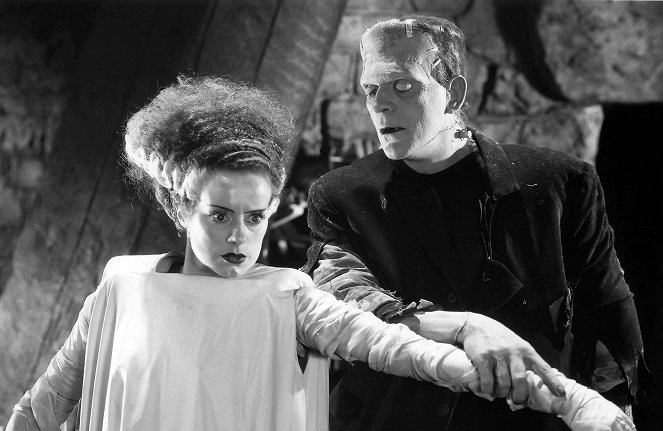
American post-war horror, giant monsters and the third dimension
During the 1940s, few horror films were made because of World War II, as more positive and uplifting entertainment took precedence. But the 1950s saw the emergence of new themes and sources of fear: the Cold War and various other threats, typically, for example, alien invasions or mutations in humans and insects caused by radiation and scientific experiments. The boom in technology contributed to film with the invention of 3D, with cinemas providing viewers with special disposable glasses that allowed them to see the projected film three-dimensionally. A film that benefited from this was House of Wax (1953), starring Vincent Price, who would become a horror icon.
The illusory third dimension was also one of the gimmicks that cinemas used to fight the competition from television. Many horror films also offered other notable attractions – for example, William Castle's The Tingler (1959), about a scientist who discovers a human parasite that feeds on fear, terrified audiences with electric buzzers built into cinema seats. William Castle was an expert in such gimmicks and marketing strategies; for example, he offered life insurance to cinema-goers in case they died of fright during a film screening, hired women dressed as nurses to promote his film Macabre (1958) in case they needed medical assistance, and the screening of his film The House on Haunted Hill (1959) was accompanied by ghosts and skeletons hanging on wires and flying over the heads of cinema-goers. Other directors later followed suit; for example, Francis Ford Coppola decided to promote his horror debut Dementia 13 (1963) with a questionnaire in which cinema-goers could test whether they were fit enough to see the film.
In addition, the 1950s also favoured horror films with giant monsters, which usually represented the consequences of man's destructive activities and efforts to play with nature, whether they were aliens, ancient organisms from the depths of the Earth or abnormally enlarged animals. This trend started with The Beast from 20,000 Fathoms (1953), which made animator and effects artist Ray Harryhausen famous and paved the way for films such as 20 Million Miles to Earth (1957), Behemoth the Sea Monster (1959) and Gorgo (1961). Among the films whose heroes fought back against overgrown animals, one should not forget Them! (1954), a horror film with giant ants, Tarantula (1955), The Deadly Mantis (1957), a film overrun by giant mantises, or The Black Scorpion (1957), a horror film with giant scorpions. The category of giant monsters already included King Kong (1933) and its numerous remakes, as well as the Japanese Godzilla (1954), thematising the fear of radiation and nuclear weapons, which resulted in the creation of an entire genre of kaiju monsters in Japan, including Rodan, Mothra, Gamera and King Ghidorah.
Tarantula (1955)
Photo © Universal Pictures
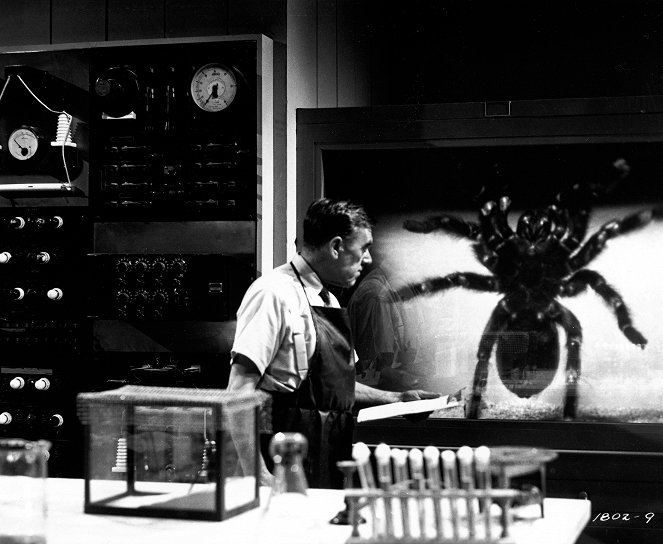
British Horror and Hammer Studios
The classic movie monsters of the 1930s survived into the 1950s thanks Hammer, a British studio that created its own versions of the Frankenstein and Dracula stories. Fewer horror films were made in the UK than in the US, yet some of them were fully comparable to the American ones, such as Dead of Night (1945) and Night of the Demon (1957). However, it wasn't until Hammer's The Curse of Frankenstein (1957) and Dracula (1958), starring Christopher Lee and Peter Cushing, that British horror achieved unprecedented success with films that differed from American horror in their greater amount of violence and gore. Christopher Lee would become an acclaimed star and was cast in many Hammer films.
The UK produced horror films throughout the 1960s (see, for example, Village of the Damned in 1960 and The Plague of the Zombies in 1966). The turn of the 1960s and 70s saw a boom in horror films with themes of folklore, witchcraft and the supernatural. This trend, represented by Witchfinder General (1968) and The Blood on Satan's Claw (1971), culminated in the successful The Wicker Man (1973), in which a Christian policeman falls victim to a pagan island cult.
Horror of Dracula (1958)
Photo © Hammer Film Productions
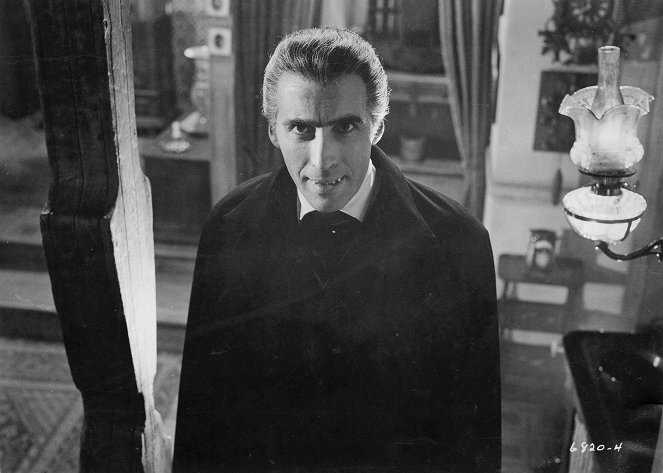
American psychological horror of the 1960s
In the first half of the 1960s, adaptations of Edgar Allan Poe's House of Usher (1960), Tales of Terror (1962) and The Masque of the Red Death (1964) were popular in the U.S., all starring Vincent Price, who also appeared in the The Haunted Palace (1963) and The Comedy of Terrors (1964). William Castle continued his horror career with Mr. Sardonicus (1961) and Homicidal (1961). But in 1960, Alfred Hitchcock revolutionized cinema with Psycho by emphasizing, unlike other horror filmmakers, the building of thick psychological tension that worked with people's subconscious and deep-seated fears. In the same year, the British horror thriller Peeping Tom was made with similar intentions, heralding the era of slasher horror with its title character, a voyeuristic killer obsessed with capturing death on film. Three years later, Hitchcock repeated his recipe for psychological horror in The Birds, enriching the genre with animal horror.
Roman Polanski entered the world of psychological horror in 1965 with his film Repulsion, conceived as a study of the mental disintegration of a paranoid girl plagued by hallucinations and nightmares. But the peak of his horror period was Rosemary's Baby (1968), about a pregnant woman who suspects her neighbours are members of a satanic sect bent on giving birth to the Antichrist. This led to a trend of films that did not work with visible horror, but rather with something only perceived and hinted at, which was often even more effective in inducing fear than terrifying monsters or shocking brutality. At the same time, horror filmmakers began to focus more on the artistic and aesthetic qualities of their work, which essentially gave birth to modern horror in the early 1970s.
Psycho (1960)
Photo © 1960 Paramount Pictures
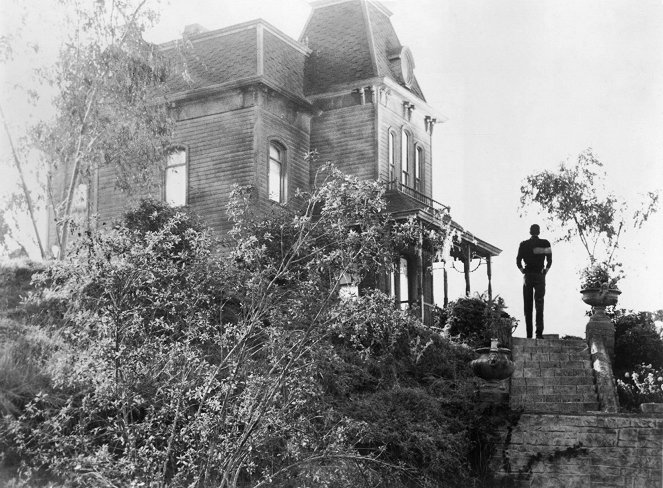
Zombies and George A. Romero
Another milestone in the history of horror was achieved by director George A. Romero with his debut Night of the Living Dead (1968), in which he first introduced zombies as the walking dead brought to life by a kind of viral contagion and attacked people in an attempt to consume their brains and flesh. The term zombie, related to the cult of voodoo, until then represented only a person enslaved under the influence of narcotics, but Romero popularized zombies as shambling and wheezing pale corpses that symbolized the generally mindless and unthinking human masses that were succumbing to, among other things, consumerism. Romero then developed this thesis into a consequence in the sequel to Night of the Living Dead, Dawn of the Dead (1978), which he followed up with four more films in the following decades.
After the turn of the millennium, zombies became a much more predatory threat, a fast, swarming army of hungry bodies with residual intelligence. Danny Boyle's 28 Days Later (2002) and Zack Snyder's Dawn of the Dead (2004) were groundbreaking in this regard. World War Z (2013) and Army of the Dead (2021), as well as the Resident Evil franchise (2002-2016), were also big American hits. Among the non-US representatives of the zombie-horror genre that have been successful worldwide, we can mention the Spanish REC (2007) or the South Korean Train to Busan (2016). Zombies would also become the antagonists of many horror comedies, such as the British Shaun of the Dead (2004), the American Zombieland (2009) or the Norwegian Dead Snow (2009).
Night of the Living Dead (1968)
Photo © Reel Media International
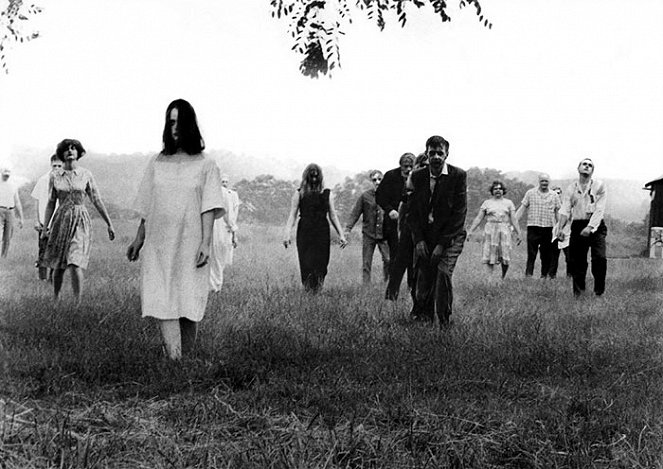
Italian and other European horror films
Until the 1960s, in addition to films from Germany and Great Britain, some films from France (The Fall of the House of Usher from 1928, Eyes Without a Face from 1960), Finland (The White Reindeer, 1952) and Sweden (Häxan: Witchcraft Through the Ages, 1922) were important in the history of European horror. From the 1960s, however, Italy became the most influential country in European horror, especially thanks to director Mario Bava, who made a name for himself abroad with his film Black Sunday (1960), and continued to build his career mainly on horror films, which often had a major influence on the future development of the genre. For example, The Girl Who Knew Too Much (1963) laid the foundation for the Italian Giallo genre and A Bay of Blood (1971) influenced many later slasher films, inspiring, for example, the creator of Friday the 13th (1980).
The characteristic features of Giallo films were explicit bloody murders, psychological themes of madness and paranoia, voyeurism, sexual themes, a strong musical soundtrack, a highly stylized visual component, a surrealistic atmosphere and unconventional pictorial compositions, often fetishistically focused on various objects or parts of the human body. Usually these films had detective or crime plots, but many also fell into the horror genre and established a number of Italian filmmakers, such as Antonio Margheriti (Castle of Blood, 1964), Riccardo Freda (The Ghost, 1963) and especially Dario Argento. He debuted in 1970 with The Bird with the Crystal Plumage and continued his career with Deep Red (1975), Suspiria (1977), Inferno (1980), Tenebrae (1982) and Phenomena (1985), which became cult classics and earned him a reputation as one of the most distinctive and influential figures in horror cinema.
After the success of Lucio Fulci's cheap horror film Zombie (1979), Italian producers focused more on zombies and on trashy horror full of perversion and nastiness, some of which directed with machine-gun frequency by Fulci himself (e.g. The House by the Cemetery, The Black Cat and The Beyond were all made in 1981). Other filmmakers that made horror films in Italy include Lamberto Bava, son of Mario Bava (Demons, 1985), Umberto Lenzi (Ghosthouse, 1988) and Joe D'Amato (The Grim Reaper, 1980 and Absurd, 1981). Significant horror films were being made at the time in Spain (Hunchback of the Morgue, 1973, Anguish, 1987), France (Possession, 1981), Sweden (The Visitors, 1988) and Poland (Alchemik, 1988).
Deep Red (1975)
Photo © Rizzoli Film

Modern horror, slashers, and Stephen King
The infernal theme used in conjunction with motherhood in Rosemary's Baby was picked up by directors William Friedkin in The Exorcist (1973), about a desperate mother forced to call an exorcist to help her demon-possessed daughter, and Richard Donner with The Omen (1976), about a married couple who discover that their adopted son is the Antichrist. The rise of several serial murderers in the first half of the 1970s inspired filmmakers to make violent, bloody films dealing with killers. Director Wes Craven introduced himself in this vein in 1972 with the horror thriller The Last House on the Left, and five years later he made The Hills Have Eyes (1977), eventually becoming an acclaimed horror director. 1974 saw the release of Black Christmas, a horror film in which a group of college students are stalked during the Christmas holidays by an unknown psychopath.
The proliferation of films featuring a variety of killers led to the creation of a separate horror subgenre, the slasher film, which enjoyed its heyday roughly between 1974 and 1988. During this period, Tobe Hooper made the brutally straightforward The Texas Chainsaw Massacre (1974), which dealt with the fate of the victims of a family of killers and cannibals led by the terrifying Leatherface; director John Carpenter made Halloween (1978), about masked killer Michael Maers, The Friday the 13th franchise (1980 onwards) gave the world the machete-wielding, hockey-masked Jason Voorhees, Wes Craven's A Nightmare on Elm Street (1984) captivated with a disfigured Freddy Krueger who murdered his teenage victims in their dreams, and Child's Play (1988) transformed a dying killer's soul into a child's doll. All of these films have become immortal classics and key representatives of the horror hall of fame, and have received many sequels and remakes.
In addition, the 1970s saw the first adaptations novels by Stephen King, a writer who became the king of literary horror and was behind dozens of notable and successful films, many of which were horror. The first was Brian De Palma's Carrie (1976), followed by Stanley Kubrick's The Shining (1980), which was based on themes of isolation in a snowy mountain hotel, alcoholism, telepathy and a descent into utter madness. In 1979, Stuart Rosenberg made The Amityville Horror, a film about a cursed house, which was followed by Tobe Hooper's Poltergeist (1982) with a similar theme. The theme of killer animals was revived by Steven Spielberg with Jaws (1975), the success of which launched a huge number of other shark (but also crocodile, spider, rat, and snake) horror films.
The Exorcist (1973)
Photo © 1973 / 2000 Warner Bros.

Splatter and body horror
The popularity of slasher films in America in the 1980s was nurtured by endless sequels Friday the 13th, Halloween and A Nightmare on Elm Street, with My Bloody Valentine (1981) and Sleepaway Camp (1983) falling into the same category. There were also many horror B-movies, and thanks to the huge boom in videotapes, many old classics, half-forgotten gems, and little-known European horror films, especially Italian ones, were also dusted off. Other specific subgenres began to come to the fore, such as splatter, which was a label for films containing brutal gory scenes and explicit violence. Bloody films were already being made in the 1950s, but it wasn't until Blood Feast (1963), about a deli owner who killed women and butchered them into his dishes to honour Egyptian deities, that the first splatter film was officially considered as such.
Splatters were very popular in the 1970s (I Spit on Your Grave, 1978), with cannibal-themed horror joining the ranks in the following decade thanks to the success of the controversial Cannibal Holocaust (1980), which was passed off as an authentic documentary, the makers of which were supposedly eaten by a tribe of cannibalistic natives they had come to the Amazon to film. Over time, violence in films reached a stage where it could be perceived as a comic element because of its downright excessive brutality, especially when combined with imaginative and inventive gags. This is how director Peter Jackson conceived his early films Bad Taste (1987) and Braindead (1992), and how Sam Raimi, creator of the Evil Dead trilogy (1981, 1987 and 1992), began his Hollywood career. The path of comic brutality was also taken by the cheesy and obscure films of the American studio Troma, famous for Class of Nuke 'Em High (1986), Terror Firmer (1999) and Poultrygeist: Night of the Chicken Dead (2006), as well as the four-part film series The Toxic Avenger, with episodes from 1984, 1989 and 2000.
In his series of original films Shivers (1975), Rabid (1977), The Brood (1979), Videodrome (1983) and The Fly (1986), David Cronenberg focused on developing the body horror genre, whose main characteristic was its emphasis on mutations, deformations and diseases. The 1980s also saw the return of vampire horror, fuelled by titles such as Fright Night (1985), The Lost Boys (1987), and Near Dark (1987). Stephen King's popularity grew with further adaptations of his works, including Cujo (1983), the folk horror Children of the Corn (1984), and Pet Sematary (1989), followed in the 1990s by The Dark Half (1993), The Mangler (1995), and Thinner (1996). Director Clive Barker based his successful Hellraiser (1987) on the theme of hellish demons, and was followed by many sequels.
The Fly (1986)
Photo © Twentieth Century Fox Film Corporation
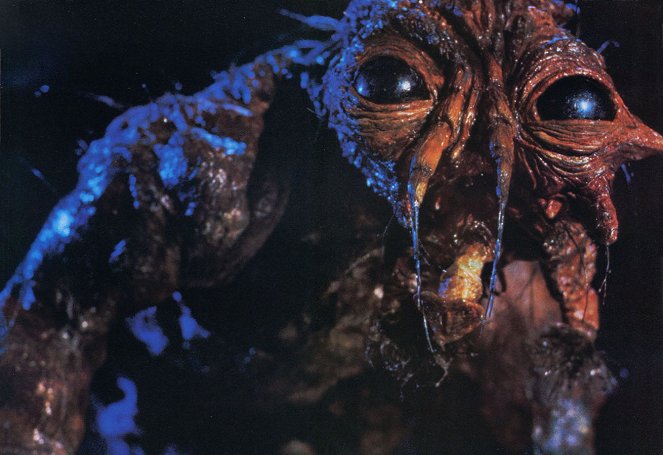
Sci-fi horror and comedy horror
The extraordinary success of Ridley Scott's pioneering horror film Alien (1979) marked not only the birth of a new iconic movie monster, but also a new wave of popularity for science fiction horror, which was followed by John Carpenter's The Thing (1982). Sci-fi horror films were already being made in large numbers in the 1950s (see, for example, 1957's The Incredible Shrinking Man, 1958's Attack of the 50 Foot Woman, and 1958's The Fly, the subject of the aforementioned Cronenberg film), but in the 1980s they took on a new life of their own, with not only a sequel to Alien called Aliens (1986), but also Predator (1987), which introduced yet another legendary alien foe (and both franchises were further developed in the years that followed).
Similarly, comedy horror films can be said to have been made since time immemorial, but it was only in the 1980s that their number began to increase rapidly. Some of them were parodies of specific horror films and the genre as such (e.g. Young Frankenstein by Mel Brooks from 1974), while others just mixed horror with black humour and crazy gags. This led to films such as Gremlins (1984), Ghostbusters (1984), Re-Animator (1985), Critters (1986), Night of the Creeps (1986), Tremors (1990), and Wes Craven's Scream series (since 1996), which poked fun at slashers. In the new millennium, the popularity of horror comedies and parodies has been followed by a series of films called Scary Movie (since 2000) and the subversive Black Sheep (2006), Tucker & Dale vs. Evil (2010), The Cabin in the Woods (2012), What We Do in the Shadows (2014), Happy Death Day (2017), and Ready or Not (2019), in which the protagonist is a victim of her fiancé’s twisted family traditions.
The Thing (1982)
Photo © Universal Pictures
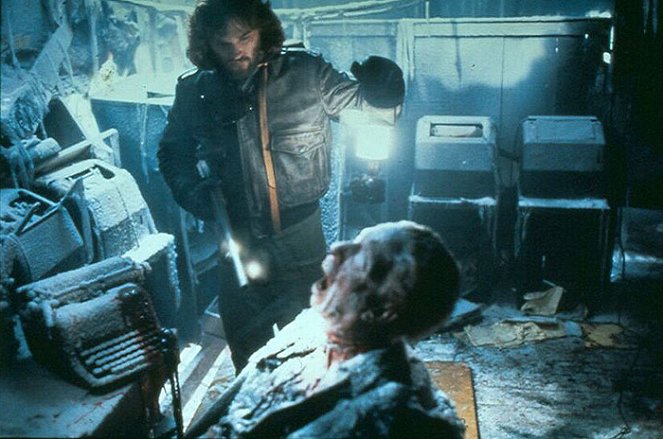
The fatigue of American horror in the 1990s
At the turn of the 1980s and 90s, horror began to slowly decline for two reasons. The first was the problematic transition of horror to television, as audiences at the time preferred more soothing and comedic shows, not to mention the censorship of TV stations and the general cheapness that many horror productions suffered from (see the 1990 two-part adaptation of King's It). The second reason was a certain fatigue of the genre as such, which, after constant sequels of slashers and gore films, slowly went off course and was replaced by science fiction, which, thanks to new technologies, found itself on the rise. The exceptions were Francis Ford Coppola's Dracula (1992) and Jonathan Demme's highly successful thriller with horror elements The Silence of the Lambs (1991), which picked up five of its seven Oscar nominations, including Best Picture and Best Director.
In addition, the 1990s also saw several meta-horror films, such as Candyman (1992) and In the Mouth of Madness (1995), and films that tried to take a new approach to old themes, such as Interview with the Vampire: The Vampire Chronicles (1994), Mike Nichols's Wolf (1994), Stephen Norrington's Blade (1998), Tim Burton's Sleepy Hollow (1999), and William Malone's House on Haunted Hill (1999). Many other films also benefited from a return to tried and true themes, whether they were slashers (I Know What You Did Last Summer, 1997), animal horror (Deep Blue Sea, 1999) or cannibalism (Ravenous, 1999). Horror films began to use digital effects (e.g. Anaconda, 1997 and Deep Rising, 1998), and this also applied to sci-fi horror, including Species (1995), Cube (1997) and The Faculty (1998). The most successful horror films of the second half of the 1990s, however, were the ghost film The Sixth Sense (1999), famous by its surprise ending, and The Blair Witch Project (1999), which became a phenomenon of Internet promotion and was a huge hit despite its meagre budget.
The Silence of the Lambs (1991)
Photo © 1991 Orion Pictures Corporation

Japanese horror
Unlike American and European horror films, which were based on the absolute eradication of evil, Japanese horror tended to suggest that even conquered evil continues to survive because it is an integral part of the world we live in. Although many Japanese horror films contained similar themes to their Western competitors (especially ghosts and demons, folkloric and shamanic motifs, and exorcism scenes), they approached them very differently. From the beginning, they relied on a slow build-up of dense tension and a foundation of psychological and supernatural horror, with older films often dealing with the aftermath of World War II and sexual violence, and more modern films usually dealing with cursed objects, haunted houses, or dysfunctional family ties. Iconic figures of Japanese horror were female characters with long black hair covering their faces, women killing men and abusing children, and vengeful ghosts.
The war and the atomic bombings of 1945 made a significant imprint on Japanese cinema through the birth of giant, destructive kaiju monsters (1954's Godzilla) and phantoms representing serious historical trauma, such as in 1953's Tales of Ugetsu, in which soldiers kill and rape women who subsequently become ghosts. The characters of female ghosts seeking revenge would later feature in similar films such as Onibaba (1964) and Kuroneko (1968), and the anthology film Kwaidan (1964) also dealt extensively with ghosts. From the mid-1960s to the end of the 1980s, the so-called pinku films made on low budgets by small independent studios were popular with erotic and sexual themes, often combined with horror and exploitation (Assault! Jack the Ripper, 1976). In 1989, the haunted house theme was explored in Sweet Home, and the surreal cyberpunk Tetsuo: The Iron Man was another notable success that year, eventually becoming a cult hit.
In the second half of the 1990s and at the turn of the millennium, modern Japanese horror became successful thanks to a return to the ghost theme, with films such as Ring (1998), Dark Water (2002) and The Grudge (2002), which also dusted off the motif of the mother-child relationship. The horror films Pulse (2001), Suicide Club (2001) and Exte: Hair Extensions (2007) also became big hits. The international popularity of many of these films caused the American market to demand remakes (The Ring was remade in 2002, The Grudge in 2004, and Dark Water in 2005), which directed the attention of audiences to their original versions. Similarly, various American horror films took their cues from other Asian countries, such as Thailand (Shutter, 2004) and Hong Kong (The Eye, 2002). Other acclaimed Japanese horror directors include Hideo Nakata, Sion Sono, Takashi Shimizu, Kaneto Shindo and Takashi Miike (Audition, 1999).
After 2000, Japan also began producing extremely brutal horror films characterised by the fetishisation of iconic elements of Japanese culture and exceptionally gory scenes that were deliberately comic in their over-the-top and exaggerated violence. They were made to appeal to foreign audiences hungry for bizarre Japanese eccentricities, and usually emphasized characters undergoing biological mutations (2008's Tokyo Gore Police or 2010's Mutant Girls Squad) or mocking traditional Japanese themes (2009's RoboGeisha or 2012's Dead Sushi).
Ju-on: The Grudge (2002)
Photo © 2004 Lions Gate Films
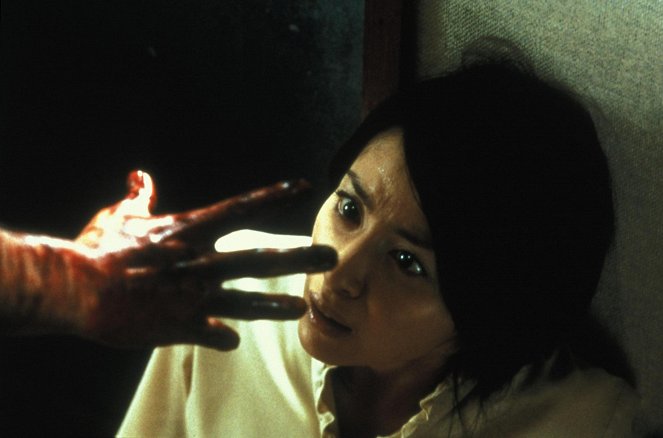
Horror films of the new millennium, remakes and found footage
Of the horror films made shortly after 2000, the most memorable are Final Destination (2000), about a group of students who accidentally avoid a tragic accident, but death eventually finds them anyway, The Others (2001), a psychologically distressing horror film about a mother whose children are allergic to daylight, and 28 Days Later (2002), which revived the zombie horror genre. Horror directors Eli Roth made his debut with Cabin Fever (2002), and Rob Zombie with House of 1000 Corpses (2003), followed by The Devil's Rejects (2005). The tradition of vampire horror was revisited by Van Helsing (2004) and 30 Days of Night (2007), as well as the Underworld series (since 2003), while the heroes of Constantine (2005), The Exorcism of Emily Rose (2005) and Drag Me to Hell (2009) had to deal with demons. The success of the video game-inspired horror franchise Resident Evil (since 2002) led to the adaptations Doom (2005) and Silent Hill (2006). In 2007, 1408 and The Mist were made based on Stephen King’s works.
The success of The Blair Witch Project led to a boom in "found footage", films shot in the style of home movies on handheld cameras, whose creators tried to pass them off as authentic footage. This specific form, first introduced in Cannibal Holocaust, was followed by Diary of the Dead (2007) and Cloverfield (2008), the remake of the Spanish film REC, called Quarantine (2008), the ghost series Paranormal Activity (since 2007) and the Canadian horror film Grave Encounters (2011). In addition, in the new millennium, producers turned to remakes of older horror films, reaching not only for Asian hits but also for American classics, producing new versions of, among others, Dawn of the Dead (2004), The Texas Chainsaw Massacre (2003), House of Wax (2005), The Hills Have Eyes (2006), The Omen (2006), Halloween (2007), Friday the 13th (2009), The Last House of the Left (2009), A Nightmare on Elm Street (2010), Maniac (2012), Carrie (2013), Evil Dead (2013), Poltergeist (2015), Suspiria (2018), Child’s Play (2019), and Pet Sematary (2019).
Among the non-American horror films of this period, the ones that stand out are the British The Descent (2005) and Eden Lake (2008), the Spanish The Devil's Backbone by Guillermo del Toro (2001) and The Orphanage by J.A. Bayona, the Norwegian Cold Prey (2006) and the Swedish Let the Right One In (2008), about the friendship between a boy and a vampire girl growing up in a housing estate. Also worth mentioning are the Danish film Antichrist by Lars von Trier (2009), the South Korean I Saw the Devil (2010), the Austrian Goodnight Mommy (2014), the Czech Ghoul (2015), and the French Raw (2016), which worked with the motif of cannibalism.
The Others (2001)
Photo © 2001 Dimension Films
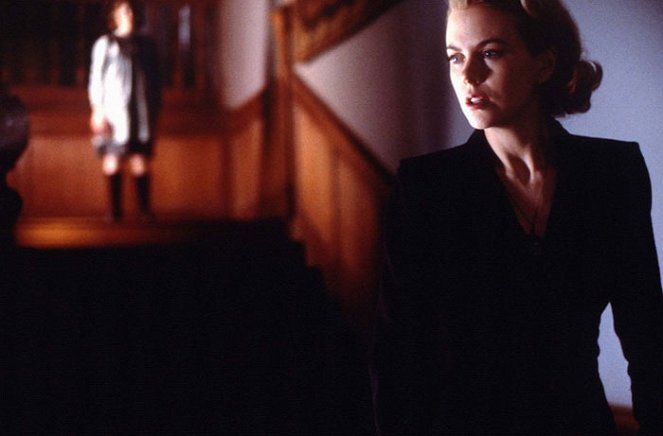
Torture porn and the French extreme wave
Between 2003 and 2009, films labelled as "torture porn" became particularly trendy. Based mainly on extreme bloody violence of a sadistic nature, they were usually not too expensive to produce and easily became big audience hits. The most successful in this respect was the multi-part American series Saw, directed by James Wan (from 2004), whose heroes had to deal with traps, torture devices and deadly labyrinths constructed by a psychopath who tried to teach them to value life.
The most prominent representatives of this sub-genre, however, were films referred to as the French Extreme Wave, such as High Tension (2003), Frontier(s) (2007), Inside (2007) and Martyrs (2008). Eli Roth succeeded with his pair of films Hostel (2005) and Hostel II (2007), about the fate of visitors to a Central European hostel whose basement serves as a torture chamber for a wealthy foreign clientele. Other horror films that had significant impact were The Human Centipede (2009), the Japanese Grotesque (2009) and the Serbian A Serbian Film (2010), which was set in a milieu of marginalised porn actors.
Saw (2004)
Photo © Lionsgate

The renaissance of ghost horror
After the extraordinary success of James Wan's The Conjuring (2013), ghost-themed films became hugely popular, as well as films whose protagonists had to deal with various types of demons and ancient curses. The fictional world of The Conjuring and its sequels The Conjuring 2 (2016) and The Conjuring: The Devil Made Me Do It (2021), built around the mysterious cases of a pair of real-life paranormal investigators, was followed by a series about the demon-possessed doll Annabelle (since 2014), along with The Nun (2018) and The Curse of La Llorona (2019). Other films featuring demons include Sinister (2012), Mama (2013), The Babadook (2014), and Lights Out (2016), as well as the multi-part Insidious franchise (since 2010).
Among the horror films of other types made after 2010 notable examples include Oculus (2013), about a cursed mirror, It Follows (2014), whose characters pass a deadly curse to each other through sexual intercourse, The Autopsy of Jane Doe (2016), which takes the witchcraft theme into the setting of an autopsy room, and The Purge series (since 2013), set in a world where it is possible to commit any illegal activity one night a year. The anthology film Ghost Stories (2017), the wartime Overlord (2018) and the hypnotic Mandy (2018) were also very impressive. At the same time, Universal attempted to revive its classic monsters in The Wolfman (2010), Dracula Untold (2014), The Mummy (2017) and The Invisible Man (2020).
Doctor Sleep (2019), a sequel to The Shining, Andy Muschietti's new two-part adaptation of Stephen King's It (2017 and 2019), Jordan Peele's Get Out (2017), praised for combining horror with issues of racism, and John Krasinski's A Quiet Place (2018), about a family hiding from noise-reacting monsters, all made successful contributions to the history of the horror genre. The most notable horror directors of this period include Robert Eggers and his historical fable-influenced films The Witch (2015) and The Lighthouse (2019), and Ari Aster and his progressive horror films Hereditary (2018) and Midsommar (2019).
The Babadook (2014)
Photo © Wild Bunch Distribution
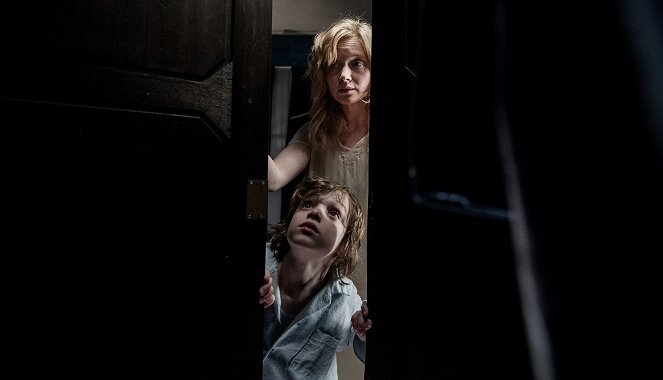
TV horror series
Horror films began appearing on TV in the 1950s, and it was this medium that provided many filmmakers with their first ever encounter with the genre. Among the most popular shows of the time were the short story series Alfred Hitchcock Presents (1955-1965), in which the acclaimed director introduced viewers to a variety of thrillers, mystery dramas, crime stories and horror films, and The Twilight Zone (1959-1964), whose themes often fell into the sci-fi genre. In the following decades, the horror series The Addams Family (1964-1966) and Dark Shadows (1966-1971), as well as many short story series and TV horror films, were popular.
In the 1980s, both The Twilight Zone and Alfred Hitchcock Presents received new versions, and the anthology series Tales from the Crypt (1989-1996) was also a success. In terms of TV horror, the late 1990s were marked by Buffy the Vampire Slayer (1997-2003), which was aimed primarily at a teenage audience, and Lars von Trier's multi-genre The Kingdom (1994-1997), which appealed to a more mature and discerning audience. The advent of the new millennium brought paranormal investigator series such as Supernatural (since 2005) and Ghost Hunters (2004-2016). Among anthology horror American Horror Story (since 2011) stood out, but there also were notable series with continuous narratives, such as The Vampire Diaries (2009-2017), The Walking Dead (since 2010), Hannibal (2013-2015), Penny Dreadful (2014-2016), and The Haunting of Hill House (2018).
Filmmaniak
Best horror films
The Silence of the Lambs (1991) |
Alien (1979) |
Aliens (1986) |
The Sixth Sense (1999) |
Psycho (1960) |
The Shining (1980) |
Predator (1987) |
The Thing (1982) |
The Cabinet of Dr. Caligari (1920) |
Wait Until Dark (1967) |
| All the best horror films |


